TLDR: The Beretta 1301 is the best value semi-auto shotgun on the market today. I’ve put thousands of rounds through this shotgun and I don’t think I have ever had a malfunction, ever. I’ve had zero malfunctions despite going over two years without cleaning it and frequently shooting in rain and snowstorms. It’s a smooth shooting shotgun and the fast cyclic rate means you can pop off accurate follow-up shots swiftly. It’s cool and you should get one.
- Firearm Type:
- Shotgun
- Cartridge/Gauge:
- 12 Gauge shotgun.
- Manufacturer & Country of Origin:
- Beretta (Fabbrica d’Armi Pietro Beretta), Italy.
- Chamber:
- Chamber accepts 2 & 3/4 inch (70mm) and 3 inch (76mm) shells.
- Action type:
- Gas operated semi-automatic shotgun, short stroke piston, rotating bolt.
- Barrel length:
-
18.5 inch (46.99cm) on Tactical model.
21-24 inch (53.34-60.96cm) vent rib barrel on Comp & Comp Pro models. - Choke:
-
Comp: Optima HP Removable Choke, ships with an IC Improved Cylinder.
Comp Pro: extended Optima HP Removable Choke, ships with an IC Improved Cylinder.
Tactical: Available* in fixed cylinder bore or Optima HP Removable Choke.
*Some sources say that fixed choke cylinder bore versions are only available to military/law-enforcement. - Stock
-
Tactical: Sporting configuration, optionally with a fixed stock and pistol grip.
Comp: Sporting configuration stock, adjustable length of pull and comb.
Comp Pro: Sporting configuration recoil-reducing stock branded “Kick-Off Plus”. Adjustable comb and length of pull. - Length of Pull:
-
Tactical Model, 13 inch (33.02cm).
Comp & Comp Pro features adjustable length of pull. - Weight:
-
6.4 lbs, 2.9 kg.
*Weight will vary somewhat depending on exact trim package and accessories. - Magazine Capacity:
-
6-7 shells plus 1 in the chamber, depending on exact cartridge used.
*This shotgun can be ghost loaded with an additional shell resting on the elevator inside the loading port. Ghost loading will bring the capacity up by an additional shell more than listed above.
**Extended magazine extension tubes are available from the manufacturer along with several reputable aftermarket dealers such as Nordic Components.On my test model with a 24″ barrel, a flush-with-barrel magazine extension holds 8 cartridges.
- Sights/optics:
-
Tactical: Front blade with Ghost ring rear sight along with 1913 picatinny optics rail included.
Comp & Comp Pro: Front fiber optic sight with mid-mounted brass bead, receiver is drilled & tapped for an optics rail.
Beretta 1301 Specifications:
The Beretta 1301 is a gas-operated, semi-automatic shotgun known for its extreme reliability and compelling value. Note that I didn’t say cheap, I said value. Value is relative. Most, if not all, semi-auto shotguns that are cheaper than the 1301 are recoil operated, which is a less desirable configuration. Sometimes called an auto-loader, self-loader or automatic, these shotguns can be fired as fast as you can pull the trigger with no other action needed by the shooter between shots. Among autoloaders, this shotgun claims to be the fastest cycling semi-auto on the market thanks to its “Blink” operating system. If branded terms like “Blink” and “Steelium” entice you, then you’ll love the 1301’s spec sheet. Steelium is the made-up word that Beretta uses to describe the hammer-forged steel barrel material and I think the name sounds stupid. When I purchased the 1301, I opted for the Comp version intended for multigun shooting competitions. While the 1301 in Tactical trim has a lot going for it as well, the somewhat longer barrel and removable choke allowed for more flexibility in intended use.

Strange branding and silly Steelium name aside, I love the shotgun and after many years of hard use I would never consider selling it.
If you want a shotgun with which to defend yourself and your family should the (unlikely) worst-case scenario occur, then you want high performance and reliability more than you want “cheap.” While I am not and never have been a Door-Kicker/Operator/Soldier/Law-Enforcement-Officer, I strive to be a well-armed, well-trained, highly competent, lawful civilian who values the Second Amendment and protecting my family. The Second Amendment entails civilians possessing and training with firearms that have a fighting and defensive level of reliability. In my opinion, the Beretta 1301 meets and exceeds this standard.
First Impressions
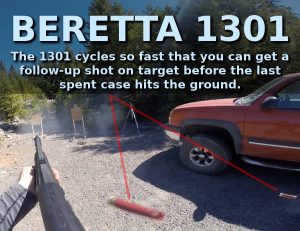
Aesthetically, I really like how this shotgun looks. It’s sleek and well thought out, without being pretentious or overly complicated. The stock and fore-end feel a bit plasticky, but they’re well contoured and ergonomic. I like that I can change the stock’s comb and length of pull. I love the trigger, it’s light and crisp and the bright chrome trigger finish is smooth and adds just a hint of bling to an otherwise subdued look. The gun cycles extremely fast so I can pop off very quick follow-up shots. The recoil is smooth for a light shotgun. Overall, it’s a very fun gun to shoot and the great reliability I’ve had with it makes me very confident that it would function reliably in an emergency.
I bought this shotgun about 6 or 7 years ago after having trouble with other manufacturers. At the time, I had witnessed shotguns at budget price points routinely fail in 3-gun competitions. So, after having some bad experiences with shotguns that I owned or borrowed, I felt it necessary to invest in something higher up in the price category. To the uninitiated, the prospect of an affordable and reliable semi-auto shotgun seems easy enough to achieve. But, real life experience has shown me that there are three trade-offs when buying a shotgun:
- Cheap
- Reliable
- Semi-automatic
Choices When Picking A Shotgun (Pick 2)
Of the 3 choices above, you can pick out a shotgun that is both cheap and semi-auto; but reliability will suffer. In contrast to the Beretta, you can also pick out a cheap and reliable shotgun that won’t be semi-automatic (Mossberg 500/590 or Remington 870). So, where does that leave us? In my experience, if you want a reliable semi-auto shotgun you’re gonna have to spend some money. It seems like it should be simple and easy to make a reliable and affordable semi-auto shotgun. However, when we look at the extremely wide range of ammunition and conditions that shotguns are used in, making a reliable “autoloader” is anything but easy. From near-freezing waterfowl marshes to high round counts during heated shooting competitions, shotguns have big shoes to fill. Especially among hunters, competitors and civilians interested in self defense. All of these groups demand flawless performance from their scatterguns. Of course, I should define what I mean by “reliable” a bit better.
Should I Get a Beretta 1301? Be Realistic About Your Use Case
Terms like reliable, value and affordable all depend on one’s budget, priorities and use-case. Many Second Amendment supporters are gun collectors and/or casual, recreational shooters. Leisurely, casual enjoyment of guns and shooting is certainly a valid use-case for owning firearms. But, casual shooting may not demand the same level of quality, durability or reliability that a more serious shooter values. Similarly, a collector is probably more interested in the cultural/historical significance or visual esthetic of a firearm rather than its primary function of shooting things. For the collector, a less reliable, more expensive shotgun that was featured in a Hollywood movie like Jurassic Park may be much more desirable, despite the fact that it’s not as reliable (shout-out to the SPAS-12). Also, do you plan on using a shotgun as one of your primary defensive firearms? What’s your total firearms budget? Do you need a weapon light and a reliable red dot on your defensive rifle first? Probably. How much time will you devote to practice? Use case matters.
If you’re a casual shooter who goes hunting a few times a year, your idea of reliable may be different. If you use your shotgun to shoot at watermelons on 4th of July and blast pumpkins on Halloween, then maybe a cheap semi-auto will work for you. Better yet, why not just get a reliable pump shotgun? On the other hand, if you expect to shoot thousands of rounds per year out of your shotgun in harsh conditions using a wide range of ammunition, then your standards are more like mine. A gas operated semi-auto shotgun will allow you to shoot faster while mitigating recoil compared to a pump shotgun. I expect flawless, high-level performance from my firearms in all weather:
- Hot, dusty summers
- Snow & ice in subfreezing conditions
- Pacific Northwest near-freezing rainstorms
Year Round Firearm Performance
I need my guns to work reliably, especially in foul weather.
Is It a Good Deal?
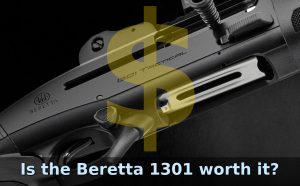
Currently, MSRP for the 1301 Comp is around $1,300 ($1,675 for the Comp Pro), however the test gun was purchased for $900ish dollars about 6 years ago. Note that I call this shotgun a compelling value, but with Turkish shotguns available for half the price I certainly wouldn’t call the Beretta cheap. Beretta currently offers the 1301 in a few different trim levels, Tactical, Comp and Comp Pro versions. Cheap is a relative term that also carries a negative connotation that disparages the item’s quality. The 1301 is not cheap. But, when compared to gas operated shotguns like the Benelli M4 (also owned by Beretta), starting around $2,000 then the 1301 seems like a bargain. If you can find a 1301 Comp, a current fair street price is about $1,100.
In my opinion, the 1301 is the most bang-for-the-buck, highest value semi-auto shotgun on the market today.
Beretta 1301 Problems
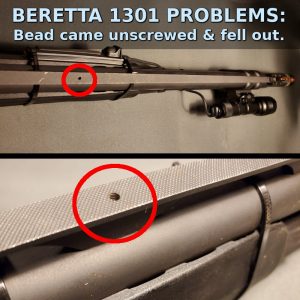
When I purchased this firearm, the owner’s manual explained that it would cycle all rounds, with a minimum recommended 1 and 1/8th oz target load. Over the last 6-7 years I’ve found it to be extremely reliable. In all the rounds I’ve put through the shotgun, I don’t believe that I’ve ever had a malfunction, ever. As far as cleaning, I have cleaned this shotgun less than once a year and it has never failed due to lack of cleaning. While I don’t keep exact round counts, I’ve probably put at least 6-7k rounds through the shotgun including far more high brass and high-power slug rounds than average shooters would. The only reason I’ve ever cleaned the gun is when I needed to take it apart to smooth out the loading port for faster quad-loads etc.
I’ve only had two problems with the 1301 in all my years of ownership and hard use. The first problem was that the brass site bead came loose, fell out and got lost a few months into ownership. Beretta should have used Thread-Sealer (LockTite) on their sites. While minor, that issue was the manufacturer’s fault. The second issue I had with the Beretta was my fault. I used this shotgun in very bad weather, including rainstorms, snowstorms, hail, sleet and all of the near-freezing moisture that the Pacific Northwest mountains are known for. During these dozens of harsh winter shooting sessions, I did not clean the shotgun for over 2 years. The repeated moisture and lack of lubrication caused the adjustable choke to rust into the barrel. I ended up destroying the choke getting it out and I almost ruined the barrel in the process. Thankfully, I finally got the choke out and was able to chase the threads and get a replacement choke insert so I’m good to go.
The other Beretta 1301 problems that I’ve seen but have not personally experienced is that the plastic covered charging handle can be damaged if the gun is slammed down onto rocks/concrete. In these scenarios, the plastic portion of the handle can be dislodged and jam the gun. If someone is worried about this, there’s a strong aftermarket for the platform and there are affordable all-metal charging handles available.
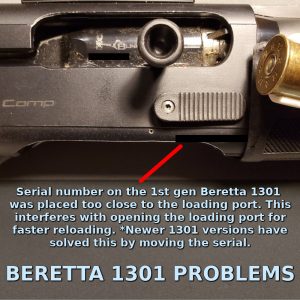
There is one issue that may or may not be a problem for you, depending on your use case and where you live. The 1301’s serial number is low on the receiver such that if you wanted to aggressively cut out material from your receiver, it may remove the serial. Depending on your state laws, removing the serial number may be illegal or it may keep you from being able to sell/trade the gun later on. Does this matter to you? Probably not. But, for 3gun shooters wanting to aggressively cut up their thousand dollar shotgun with a Dremel, the serial placement is kind of a drag. NOTE: it looks like newer versions may have moved the serial to a better spot that’s out of the way of adventurous 3gun Dremels.
Shotguns like the Mossberg 590 feature dual cartridge extractors, which they claim offers superior reliability. Whereas, this Italian only has one extractor. Despite the 1301 only having a single extractor, I’ve never had it fail to extract a cartridge. The Beretta’s internal parts seem very precise and well-made. When comparing the internals of the 1301 to other shotguns like the 590, the 590’s parts seem beefier, if less refined. The 1301 internal parts are polished and lightweight. The trigger pack has a plastic housing, presumably to save weight and cost. Some may prefer a more rugged metal trigger housing, but the plastic housing has not caused me any problems despite the gun being bumped around and roughly dumped into buckets etc during competitions.
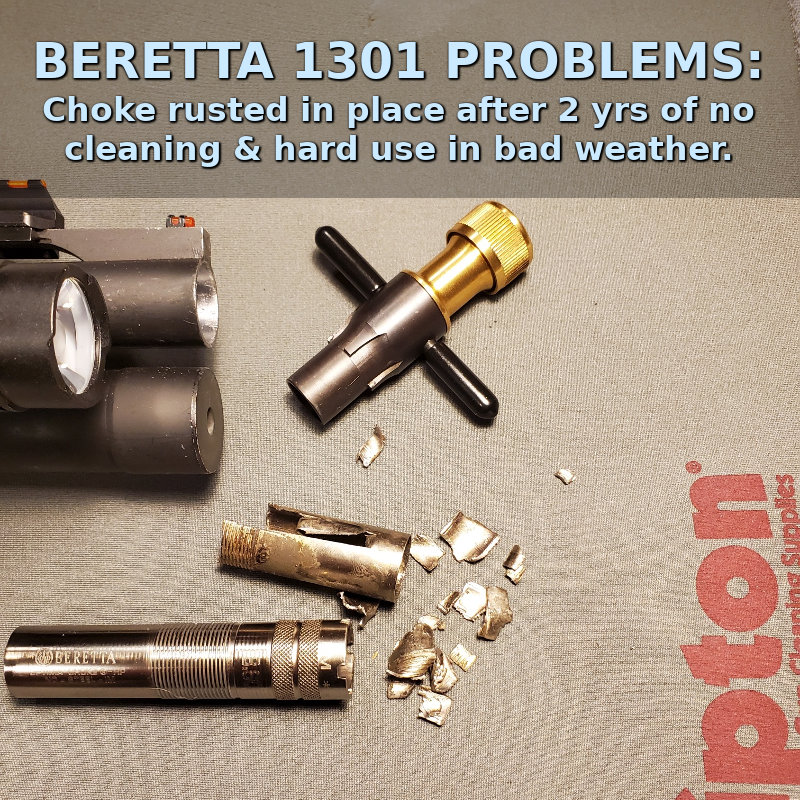
Which One Should I get?
For pure usefulness and value’s sake, I’d go with the 1301 Comp hands down. For ultimate performance and if I had to buy one now, I’d probably go bling and get the 1301 comp Pro, which has the fancy colored anodized frame along with a factory recoil-reducing stock. As for what Barrel length, I’d personally go with the 24″ barrel because in 3gun everyone runs a long magazine tube extension anyway. It makes no sense to have a short barrel if you also have a long extension and to me it looks silly that way. Also, I grew up using waterfowl shotguns with really long barrels so a 24″ barrel seems handy and short to me.
For those wanting ultimate CQB performance, you could make an argument for the 18″ barrel or even an SBS (Short Barreled Shotgun), but for me I’d take a medium length barrel along with an extension that fits flush with the barrel. For me, shotguns are a multi-use firearm and this wide use-case makes the 24″ barrel the best choice. Sure, the 18″ barrel is the tacticool choice for CQB, but what if you need to defend yourself and also hunt for food?
For a factory competition gun, I love the fact that Beretta made the loading port oversized, along with the cartridge elevator and fire controls. Given that shotguns are notoriously slow to reload, why don’t all gun manufacturers make oversized and smoothed out loading ports standard? However, the oversized bolt release is more of a mixed blessing; there have been a few times where I accidentally activated the oversized bolt release when I didn’t mean to. But with practice, I have found the 1301 Comp’s oversized controls easy to use and they do help me operate the shotgun faster.
The Comp version’s trigger is crisp, light and I love it. However, it may be a little too light for shooters with bad habits such as poor firearms fundamentals, specifically trigger discipline. Novice shooters with bad trigger discipline have accidental discharges, so this may not be the best NOOB gun.
Conclusions
The Beretta 1301 is best value semi-auto shotgun in terms of reliability and performance for the money. It might even be the best semi-auto shotgun, period. I’ve never had mine fail on me and I can’t see a functional reason to spend more and get a more expensive Benelli M4, except for coolness factor.
